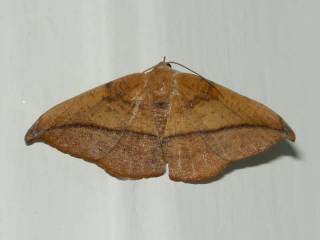Well, no sooner did I finish Friday’s post than I checked bugguide.net again, and the folks there had been busy already! They pointed me to a great website for those who have no idea how to begin ID’ing a moth: mothphotographers. They have a great walkthrough of most (all?) of the moth families in the US, and if you, like me, have no idea where to begin, it’s extremely helpful.
The respondent at bug guide also proferred a tentative ID: Patalene olyzonaria, not uncommon in the Southeast, but a bit of a puzzle as to why it would appear inside my house. It seems to be a woodland creature, having a liking for juniper and pine needles.
Here it is again, in case you’ve forgotten what it looks like:
It’s in the large moth family Geometridae, which gets its name (earth-measurer) from the way the larvae move around: for those of you who know it, it’s the “inchworm” gait; for those of you who don’t, here is Wikipedia’s attempt to describe it:
The name “Geometridae” ultimately derives from Latin geometra from Greek γεωμέτρης (“geometer, earth-measurer”). This refers to the means of locomotion of the larvae or caterpillars, which lack the prolegs of other Lepidopteran caterpillars in the middle portion of the body, with only two or three pairs at each end. Equipped with appendages at both ends of the body, a caterpillar will clasp with its front legs and draw up the hind end, then clasp with the hind end (prolegs) and reach out for a new front attachment – creating the impression that it is measuring its journey.
A picture would be worth a thousand words here, don’t you think:

I’m still trying to track down the etymology of Patalene; the best I can do so far is some form of Sanskrit, either Pâtâla, the nether world, or potala, “a station for ships,” from pôta, vessel, which was a place name for a village on the Indus river delta in Alexander the Great’s time. That latter is not impossible, but not particularly plausible, either, given that moths are often associated with darkness and the netherworld, so a genus name that means nether world makes a lot of sense. But I don’t have the whole story, so I’m just speculating here.
An even more plausible etymology would be that it’s an eponym. The German entomologist G.A. Herrich-Schäffer (often misspelled Herrick, and Schaeffer appears any number of ways) named the genus, but I don’t have anything more to go on, so I won’t go on any further.

